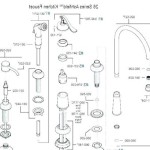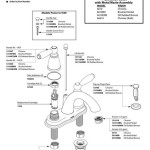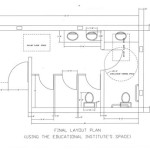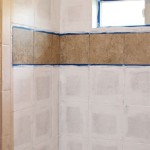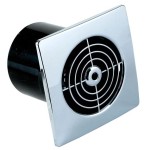How to Clean Stubborn Stains Around Your Bathroom Sink Drain
The area around a bathroom sink drain is a notorious breeding ground for stains. A combination of hard water deposits, soap scum, toothpaste residue, and general grime contributes to discoloration that can be challenging to remove. Ignoring these stains not only detracts from the overall cleanliness of the bathroom but can also foster the growth of mold and mildew, potentially leading to health concerns. Regularly cleaning this area prevents buildup and maintains a hygienic and aesthetically pleasing bathroom environment. This article offers a comprehensive guide to effectively cleaning stubborn stains around your bathroom sink drain, utilizing readily available materials and methods.
Identifying the Type of Stain
Before beginning the cleaning process, it is crucial to identify the type of stain affecting the sink drain area. Different types of stains respond better to different cleaning agents. The most common culprits are hard water stains, soap scum, rust stains, and organic stains from mold or mildew. Hard water stains, often appearing as white or chalky deposits, are caused by mineral buildup from water with high mineral content. Soap scum, a greasy film, is a byproduct of soap reacting with minerals in hard water. Rust stains, reddish-brown in color, indicate the presence of iron in the water supply or corrosion of metal fixtures. Organic stains, typically black or green, signal the presence of mold or mildew, thriving in damp environments. Visual inspection, considering the color and texture of the stain, is often sufficient for identification. Understanding the nature of the stain allows for targeted cleaning, increasing the likelihood of success.
Gathering the Necessary Cleaning Supplies
Once the type of stain is identified, gather the appropriate cleaning supplies. A well-stocked cleaning toolkit will streamline the cleaning process and ensure access to the necessary tools. Essential supplies include: *
Cleaning solutions:
Options vary depending on the stain type. White vinegar is effective for hard water stains and soap scum. Baking soda, a mild abrasive, is useful for general grime removal. Commercial bathroom cleaners are formulated for a variety of stains. Hydrogen peroxide can help with organic stains and has mild bleaching properties. For tough rust stains, a specialized rust remover may be required. *Cleaning tools:
A toothbrush, either old or specifically designated for cleaning, is invaluable for reaching tight spaces around the drain. A small scrub brush provides more scrubbing power for stubborn stains. Microfiber cloths are excellent for wiping surfaces clean and prevent scratching. A scraper, such as a plastic putty knife, can assist in removing hardened deposits. *Protective gear:
Wearing rubber gloves protects hands from harsh chemicals and potential irritants. Eye protection, such as safety glasses, prevents splashes from entering the eyes. *Other helpful items:
Paper towels are useful for soaking up excess liquid and drying surfaces. A spray bottle is convenient for applying cleaning solutions. Cotton swabs are ideal for precision cleaning in hard-to-reach areas.Step-by-Step Cleaning Methods
With the stain identified and the necessary supplies gathered, the cleaning process can commence. The following methods are organized by stain type, providing specific instructions for each scenario.
Hard Water Stains:
White vinegar is a natural and effective solution for removing hard water stains. Begin by pouring white vinegar directly onto the stained area, ensuring it is thoroughly saturated. Allow the vinegar to sit for at least 30 minutes, or longer for particularly stubborn stains. The acetic acid in vinegar will dissolve the mineral deposits. After the soaking period, use a toothbrush or scrub brush to agitate the stained area, loosening the dissolved minerals. Rinse thoroughly with water and dry with a microfiber cloth. For heavily calcified areas, consider creating a paste of baking soda and vinegar. Apply the paste to the stain, let it sit for a similar duration, and then scrub and rinse. Repeat the process as necessary until the stain is completely removed. Applying a protective sealant after cleaning can help prevent future hard water buildup.
Soap Scum:
Soap scum, a combination of soap and hard water minerals, requires a slightly different approach. A mixture of baking soda and dish soap is an effective cleaning agent. Combine baking soda and dish soap to form a paste. Apply the paste to the affected area and allow it to sit for 15-20 minutes. The baking soda acts as a mild abrasive, while the dish soap helps break down the greasy film of the soap scum. Use a scrub brush or toothbrush to scrub the area thoroughly, paying attention to crevices and corners. Rinse with warm water and dry with a microfiber cloth. Commercial soap scum removers are also available and can be used according to the manufacturer's instructions. For preventative measures, consider switching to liquid soap or using a water softener to reduce mineral content in the water.
Rust Stains:
Rust stains can be particularly challenging to remove. Lemon juice, due to its citric acid content, is a natural remedy that can be effective for mild rust stains. Apply lemon juice directly to the rust stain and allow it to sit for approximately 30 minutes. The citric acid will help dissolve the rust. Scrub the area with a toothbrush or scrub brush and rinse thoroughly with water. For more stubborn rust stains, a commercial rust remover specifically designed for bathroom fixtures may be necessary. Follow the manufacturer's instructions carefully, as these products can be harsh. Always test the cleaner in an inconspicuous area first to ensure it does not damage the sink material. In some cases, rust stains may indicate corrosion of the drain itself, requiring replacement of the drain assembly.
Mold and Mildew Stains:
Mold and mildew thrive in damp environments and can cause discoloration around the sink drain. Hydrogen peroxide is an effective disinfectant and bleaching agent that can eliminate mold and mildew stains. Spray hydrogen peroxide directly onto the affected area and allow it to sit for 10-15 minutes. The hydrogen peroxide will kill the mold and mildew and help lighten the stain. Scrub the area with a toothbrush or scrub brush and rinse thoroughly with water. For more severe mold and mildew growth, consider using a bleach solution. Mix bleach with water in a well-ventilated area, following the manufacturer's instructions for dilution. Apply the bleach solution to the stain and allow it to sit for a short period, typically 5-10 minutes. Scrub the area and rinse thoroughly. Always wear gloves and eye protection when working with bleach. Improving ventilation in the bathroom and addressing any sources of leaks can help prevent future mold and mildew growth.
Alternative Cleaning Solutions
Beyond the common cleaning solutions detailed above, several alternative options can be considered for specific stain removal needs. These alternatives may offer different benefits or be more suitable for certain sink materials.
Boric Acid:
Boric acid is a mild antiseptic and antifungal agent effective against mold and mildew. It can be used as a powder or dissolved in water to create a cleaning solution. Apply the boric acid solution to the affected area and allow it to sit for several hours before scrubbing and rinsing.Cream of Tartar:
Cream of tartar, a byproduct of winemaking, can be used as a mild abrasive for removing stains. Mix cream of tartar with water to form a paste and apply it to the stain. Let it sit for a few minutes before scrubbing and rinsing.WD-40:
WD-40, a lubricant and water displacement spray, can be surprisingly effective for removing some stains, particularly grease and grime. Spray WD-40 onto the affected area and allow it to sit for a few minutes before wiping it off with a clean cloth.Mr. Clean Magic Eraser:
A Mr. Clean Magic Eraser is a melamine foam sponge that can effectively remove scuff marks and stains from various surfaces. Wet the Magic Eraser and gently rub the stained area. Be cautious when using it on delicate surfaces, as it can be abrasive.Preventative Measures for Future Stain Buildup
Preventing stain buildup is significantly easier than removing stubborn stains. Implementing preventative measures reduces the frequency of deep cleaning and maintains a consistently clean bathroom sink area.
Regular Cleaning:
Establishing a regular cleaning routine is paramount. Wipe down the sink area with a damp cloth after each use to remove toothpaste residue, soap splatters, and water droplets. Perform a more thorough cleaning at least once a week, using a mild cleaning solution to prevent the accumulation of grime.Proper Ventilation:
Adequate ventilation minimizes moisture buildup, reducing the risk of mold and mildew growth. Ensure the bathroom is well-ventilated by opening windows during and after showers or baths. Use the exhaust fan to remove excess humidity.Addressing Leaks:
Promptly address any leaks around the sink faucet or drain. Leaking water contributes to mineral buildup and creates a favorable environment for mold and mildew. Repairing leaks prevents water damage and stain formation.Using a Water Softener:
If hard water is a recurring issue, consider installing a water softener. A water softener removes minerals from the water supply, reducing the likelihood of hard water stains and soap scum. Water softeners can significantly improve the overall cleanliness of the bathroom and other areas of the home.Applying Protective Sealants:
After thoroughly cleaning the sink area, consider applying a protective sealant designed for bathroom fixtures. These sealants create a barrier that repels water and prevents stains from penetrating the surface. Reapply the sealant periodically to maintain its effectiveness.Choosing the Right Cleaning Products:
Select cleaning products specifically formulated for bathroom fixtures. Avoid using abrasive cleaners that can scratch or damage the sink surface. Opt for non-toxic and environmentally friendly cleaning solutions whenever possible.Avoiding Harsh Chemicals:
While harsh chemicals may be effective for removing stains, they can also damage the sink material and pose health risks. Use milder cleaning solutions first and reserve harsh chemicals for particularly stubborn stains. Always follow the manufacturer's instructions and wear appropriate protective gear when using harsh chemicals.
How Do I Remove This Embedded Stain From Bathroom Sink Hometalk

How To Get Rid Of Iron And Rust Stains Once For All Water Right

How To Remove Stains From A Porcelain Sink Isavea2z Com

How Did I Get Rust Stains In My Sink Benjamin Franklin Dallas

How Do I Clean A Rusty Bathtub Hometalk

Bathroom Sink Rust Stain Doityourself Com Community Forums

Easy Way To Remove Hard Water Stains Domestically Speaking

How To Remove Rust Stains From A Porcelain Tub Or Sink Cabana State Of Mind

How To Clean A Bathroom Sink 12 Best Tips

Removing Hard Water Stains From Bathroom Sinks
Related Posts


